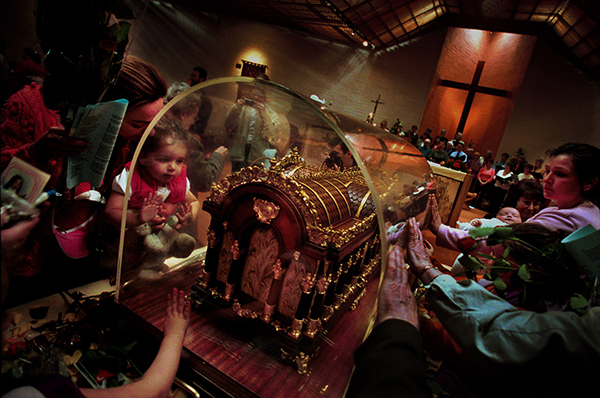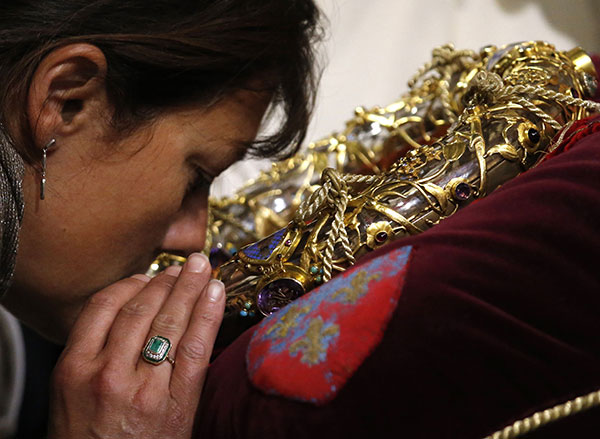The Notre Dame fire and the cult of relics
Published in Features, Issue 4 (July/August 2019), Volume 27What does the public reaction to the safe retrieval of holy relics from Notre Dame Cathedral reveal about the cult of relics in the modern world?
By Niamh Wycherley
Shocking images and live videos of a burning Notre Dame Cathedral, Paris, spread like the fire itself across the internet on 15 April this year. While the blaze continued, early reports expressed concern over the loss of Notre Dame’s priceless treasures and art, with the Crown of Thorns, reputed relic of Christ’s Crucifixion, placed top of the list. Late on the night of the fire, the mayor of Paris, Anne Hidalgo, took to Twitter to quell these fears. She praised the heroic efforts of the firefighters, police and municipal agents who formed a human chain to save Notre Dame’s artefacts, stating, ‘The Crown of Thorns, the tunic of Saint Louis and several other major works are now in a safe place’. In our supposedly secular modern age, it is perhaps surprising that such palpable fear, and relief, would be expressed over religious relics. The cult of relics has been an integral part of the Christian faith since the earliest days of the Church, however, and continues to inspire considerable popular devotion.

Above: Paris’s Notre Dame Cathedral ablaze on 15 April 2019. (Shutterstock)
History of the cult of relics
In early Christianity the veneration of relics became a key element of the cults of martyrs and saints. Relics—from the Latin reliquiae, ‘remains’ or ‘ashes of deceased human beings’—were regarded as extensions of the saint’s body and shared its sacred quality. Many items were venerated as relics. The actual body of the saint, his or her final resting place, was considered the primary location of the saint’s posthumous power, but parts of the body, items associated with the saint during his or her lifetime, such as books or clothing, and even small rags that came into contact with the tomb of a saint were all viewed as effective conduits of the saint’s essence. Proximity here was key. Saints had grown closer to Christ through death and this intimacy could be shared with those on earth who nurtured relationships with the saints. The tangibility of relics ensured the appeal of the cult. Through the perceived intervention of the saint to whom they belonged, relics were used for many purposes, e.g. to heal the sick, to effect favourable changes in the weather or to ensure victory in battle.
In Late Antiquity demand for relics grew at such a rate that exhumation and dismemberment of saints’ bodies became acceptable in some parts of the Empire. As the site of many martyrdoms in the Colosseum and the burial place of Saints Peter and Paul, Rome came under increasing pressure to share and distribute its saintly treasures. In the sixth century Pope Gregory the Great was appalled when Constantina, wife of the eastern emperor, Maurice, requested the head of St Paul or some other portion of his body. Gregory refused and explained that the custom in Rome was to put a piece of material in a box, which was then placed next to the body of the saint. This item, claimed Gregory, was just as powerful as the saint’s corpse itself. Indeed, he recounted that Pope Leo persuaded disbelievers of the authenticity of such cloths when he severed one with scissors and blood flowed from the cut.
In Late Antiquity relics were used as diplomatic gifts to facilitate the nurturing of relationships and alliances, creating a social as well as geographical network of solidarity, obligation and reciprocity. In the Middle Ages the circulation of relics bridged distances and differences between territories, expedited the creation of military networks and smoothed relations between princes. The use of relics in ecclesiastical and secular politics became a key feature of the cult of relics throughout the medieval era, as well as into the early modern and modern periods. The ability of relics to stand in for public authority, and to protect and secure the community, ensured their lasting role within the medieval Church and society.
The enduring power of relics
In his condemnation of the cult of relics in 1561, John Calvin criticised the ease with which people could be seduced by ‘this most perverse kind of superstition’. But while Calvin recognised the appeal of saints and relics as a ‘natural addiction’ (which was exploited by the Catholic Church), in seeking to eradicate it completely he perhaps did not fully appreciate how ingrained the cult was—and is—in the human psyche. The fact that relic-related devotion features in most world religions as well as in ‘secular’ or celebrity cults suggests that, from an anthropological perspective, the tangibility of the cult of relics satisfies some basic human need or desire. Some argue that celebrities have replaced medieval saints as patrons. Elvis Presley is perhaps the most famous example. He has attracted a huge cult following since his death, and millions travel every year to visit his shrine at Graceland. Many of his followers view him as a modern-day saint, in possession of special intercessory and miraculous powers, who can bridge the gap between God and mere mortals.
The cult of relics, therefore, is not just a medieval phenomenon; it is still a force in popular devotion, despite the waning support for the Church in increasingly secularised and multicultural societies such as Ireland. The urge to physically touch, kiss or just be in the presence of saintly remains survives to this day. The estimated 250,000 British and Irish visitors to the relics of St Anthony of Padua in 2013, and the millions that attended the tours of St Thérèse’s relics to Ireland in 2001, 2009 and 2012, offer us an insight into the enduring power with which saintly remains have been invested in Ireland.
Indeed, the widespread media coverage of the recovery in April 2018 of the heart of St Laurence O’Toole, stolen from Dublin’s Christ Church Cathedral six years earlier, indicates an ongoing fascination with the cult of relics. It was Laurence’s role as defender of Dublin’s interests in the twelfth century, one of the most difficult periods in the city’s history, that ensured his legacy as protector of Dublin. The heart of Laurence O’Toole, therefore, represents the heart of Dublin itself, and the theft was perpetuated against the community as a whole. Indeed, Christ Church Cathedral, as a monument, represents Dublin and is one of the city’s most famous landmarks and tourist attractions. Similarly, the reaction to the devastation of Notre Dame Cathedral in April 2019 and the fate of her relics reflects a recognition of the importance of such cultural and religious icons to the community.
The Crown of Thorns and King Louis IX
The Crown of Thorns, along with other relics of the Passion of Christ, was ‘gifted’ to King Louis IX of France in 1239 by his cousin Baldwin II, emperor of Constantinople. The emperor was forced to part with many precious imperial objects and relics in order to raise much-needed funds for his weakened realm after the Latin conquest of Constantinople in 1204. Louis acquired 22 of these treasured artefacts. Given the divine nature of Jesus Christ, items and locations associated with His life on earth were, and are, understandably at the apex of the cult of relics.
For nearly a decade afterwards, Louis engaged in the construction of the highly ornate, shimmering Sainte Chapelle in Paris, an oversized architectural reliquary, especially to house these relics. Surrounding the sacred relics of Christ’s Passion are stained-glass images that allude to Louis IX’s devotion to the Holy Land. These relics were crucial to the king’s efforts to create Paris as a new centre of Christendom in the medieval world—a New Jerusalem. The enshrinement of the Passion relics, in particular the highly symbolic Crown of Thorns, represented the relocation of the Holy Land to what is now modern-day France. Art historians have shown that the art and imagery in Sainte Chapelle was purposely created to convey complex political and religious ideals related to kingship. The whole exercise has been interpreted as groundwork for the crusades to the Holy Land upon which Louis subsequently embarked. Partly owing to these activities and his adopted role as protector of the relics of Christ’s Passion, Louis earned a reputation for sanctity during his own lifetime and was canonised after his death.

Above: Veneration of the relics of St Thérèse of Lisieux in Knocklyon church, Co. Dublin, in 2001—a reminder of the enduring power with which saintly remains have been invested in Ireland. (Alamy)

Above: The Crown of Thorns—one of the relics saved from the blaze. In 1896 it was encased in a delicate crystal and gold circular tubular reliquary. (Getty Images)
The later history of the Crown of Thorns echoes that of Paris itself. During the French Revolution, as traditional hierarchies and icons of the establishment were challenged, the Crown was removed from Sainte Chapelle. It was returned to the Church during the reign of Napoleon and instated in Notre Dame Cathedral, where it became a public symbol of faith and of the enduring power of the Church in France and a tangible link with the past. In 1896 it was encased in a delicate crystal and gold circular tubular reliquary, created with funds collected from the faithful of the diocese of Paris. The relic itself is, in reality, a barbless circle of rushes, the many thorns long since strategically dispersed by Byzantine emperors and French kings to cement contracts and authorise agreements. Its survival of the 2019 fire, in addition to two world wars and many other conflicts, has been viewed by many as miraculous. For others, however, the fate of the Crown of Thorns was sealed by mortal, not divine, power. The acclaimed hero of the hour was Fr Jean-Marc Fournier, chaplain of the Paris Fire Department, who told reporters: ‘I had two priorities, to save the Crown of Thorns and the Blessed Sacrament’. Another of Paris’s most prized relics, the tunic of St Louis IX, was saved alongside the Crown—a poetic reminder of the entwined fortunes of Louis and the relics of Christ to which he was so devoted.
Once we appreciate the overall significance of the cult of relics culturally, and the specific historical context of the Crown of Thorns and the Passion relics, the public reaction to their safe retrieval is easy to understand. These relics are more than just holy artefacts; over time they became locked into the identity of Paris itself. The loss of Notre Dame’s relics, therefore, would not only be grievous to Catholics but would also symbolise an equally egregious blow to the city, its history and its inhabitants.
Niamh Wycherley is the author of The cult of relics in early medieval Ireland (Turnhout, 2015).
FURTHER READING
R. Bartlett, Why can the dead do such great things? Saints and worshippers from the martyrs to the Reformation (Princeton, 2013).
P.J. Geary, Living with the dead in the Middle Ages (Ithaca, 1994).
M. Cohen, The Sainte-Chapelle and the construction of sacral monarchy: royal architecture in thirteenth-century Paris (Cambridge, 2014).
D. Weiss, Art and crusade in the age of St Louis (Cambridge, 1998).
















